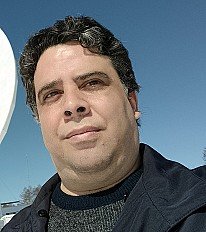
Dr. EDUARDO DE LA FUENTE ACOSTA
Resumen curricular:
El Dr. Eduardo de la Fuente Acosta estudió la carrera de Física en la Universidad de Guadalajara (egreso 1998), la Maestría en Ciencias en Astronomía en la UNAM (egreso 2002), y el Doctorado en Ciencias en Física en la Universidad de Guadalajara (egreso 2007). Realizó un postdoctorado en el Instituto Nacional de Astronomía, Óptica, y Electrónica (INAOE) y una estancia Sabática en el Instituto para la investigación de Rayos Cósmicos de la Universidad de Tokyo con director el Prof. Takkaki Kajita, premio Nobel de Fisica 2015. Es profesor investigador Titular en el departamento de Física del CUCEI, Universidad de Guadalajara desde 2008. Como investigador a la fecha cuenta con cerca de 120 publicaciones indexadas en revistas JCR de alto impacto, factor H de 34, y varios más como artículos arbitrados y memorias de congreso desde 1998, siendo Investigador Nacional Nivel II. Participa en el Laboratorio Nacional de CONACyT "High Altitude Water Cherenkov (HAWC)" desde sus orígenes en 2007 siendo el responsable de la red de cables del mismo, así como miembro del comité de publicaciones y de la Junta de la Colaboración. Ha participado en varios eventos nacionales como internacionales siendo ponente invitado en varias de ellas. Actualmente sus áreas de interés radican en el estudio de la Física de altas energías y Astropartículas. Como docente tiene experiencia desde 2003 como profesor, y perfil SEP-PRODEP ininterrumpido desde 2009. Ha tomado varios cursos de capacitación en docencia, pedagogía y tecnologías del aprendizaje, así como realizar tutorías y haber dirigido varias tesis de Licenciatura y Postgrado en las áreas de Física y tecnologías de la información. Actualmente esta cursando la Maestría en Educación Superior Internacional (MESI) en el CUCEA, enfocado al estudio de competencias interculturales en áreas STEM.
Perfil de Investigador SNII:
Bases de datos bibliográficas:
Publicaciones del académico:
- HAWC, VERITAS, Fermi-LAT, and XMM-Newton Follow-up Observations of the Unidentified Ultra-high-energy Gamma-Ray Source LHAASO J2108+5157
- Status of the ALPACA air shower array to explore sub-PeV gamma-ray sky in the southern hemisphere
- Absence of TeV halos around millisecond pulsars
- Study of Long-term Spectral Evolution and X-Ray and γ-Ray Correlation of Blazars Seen by HAWC
- γ/hadron discrimination by analysis of the muon lateral distribution and the ALPAQUITA array
- Combined dark matter search towards dwarf spheroidal galaxies with Fermi-LAT, HAWC, HESS, MAGIC, and VERITAS
- XRISM reveals a variable, multi-phase outflow-inflow structure during the X-ray obscured 2024 outburst of the black hole transient V4641 Sgr
- AMON Coincidence Alert from the sub-threshold IceCube-HAWC search NuEm-250409A
- The Hyper-Kamiokande experiment: input to the update of the European Strategy for Particle Physics
- HAWC follow-up observations of the KM3NeT neutrino event KM3-230213A
- ALPACA project to observe sub-PeV gamma-ray sky in the southern hemisphere
- Are Kronberger 80 and/or Kronberger 82 regions PeVatron candidates for LHAASO J2108+ 5157?
- Orbital Modulation of Gamma Rays up to 100 TeV from LS 5039
- HAWC Performance Enhanced by Machine Learning in Gamma-Hadron Separation
- Longtime Monitoring of TeV Radio Galaxies with HAWC
- Study of Long-term Spectral Evolution and X-Ray and γ-Ray Correlation of Blazars Seen by HAWC
- /hadron discrimination by analysis of the muon lateral distribution and the ALPAQUITA array
- The first 10years of the HAWC Gamma-Ray Observatory: science results
- Extended TeV halos may commonly exist around middle-aged pulsars
- Search for Signatures of Dark Matter Annihilation in the Galactic Center with HAWC
- HAWC, VERITAS, Fermi-LAT and XMM-Newton follow-up observations of the unidentified ultra-high-energy gamma-ray source LHAASO J2108+ 5157
- Study of the IC 443 region with the HAWC observatory
- Search for decaying dark matter in the Virgo cluster of galaxies with HAWC
- Spectral Study of Very-high-energy Gamma Rays from SS 433 with HAWC
- Analysis of the Emission and Morphology of the Pulsar Wind Nebula Candidate HAWC J2031+ 415
- Search for Joint Multimessenger Signals from Potential Galactic Cosmic-Ray Accelerators with HAWC and IceCube
- Testing the molecular cloud paradigm for ultra-high-energy gamma ray emission from the direction of SNR G106.3+2.7
- Precise Measurements of TeV Halos around Geminga and Monogem Pulsars with HAWC
- Ultra-high-energy gamma-ray bubble around microquasar V4641 Sgr
- Multiwavelength Investigation of γ-Ray Source MGRO J1908+06 Emission Using Fermi-LAT, VERITAS and HAWC
- Multiwavelength Investigation of γ-Ray Source MGRO J1908+06 Emission Using Fermi-LAT, VERITAS and HAWC
- A Spectral, Morphological, and Emission Analysis of Gamma Ray Source HAWC J2031+415
- Extending the dynamic range of the 2-inch-diameter PMT for the ALPACA experiment
- Comparing HAWC blazars light curves with different data reconstruction versions
- Searching for TeV emission from LHAASO J0341+5258 with VERITAS and HAWC
- Cosmic-ray energy reconstruction using machine learning techniques
- Nobeyama Cygnus-X Survey: Physical Properties of C18O clumps in DR-6(W), DR-9 and DR-13S regions
- Observation of the Crab Nebula and Galactic Center with the improved HAWC reconstruction algorithm
- VERITAS and HAWC observations of unidentified source LHAASO J2108+5157
- HAWC observations of microquasars as powerful particle accelerators
- First Observational Results of the ALPAQUITA Air Shower Array in Bolivia
- Mega ALPACA to explore multi-PeV gamma-ray sky in the southern hemisphere
- HAWC measurements on the total energy spectrum of cosmic rays
- Performance studies of the ALPACA experiment
- The Boomerang PWN and its SNR G106.3+2.7 Viewed in the Very-High-Energy Gamma-Ray Regime by the HAWC Observatory
- Hadronic interaction model dependence in cosmic Gamma-ray flux estimation using a surface air shower array with an underground muon detector
- TeV Halo Study of Geminga and Monogem with HAWC
- New Front end and trigger electronics for the ALPACA experiment
- Overview status of the ALPACA experiment
- High energy gamma ray emission from HESS J1809-193: Morphological and Spectral studies with HAWC


